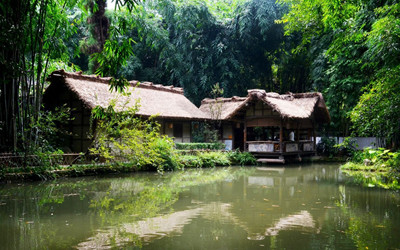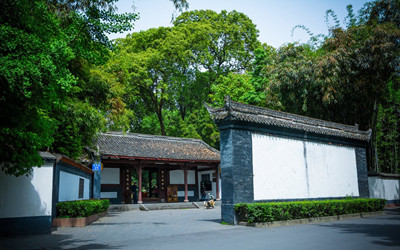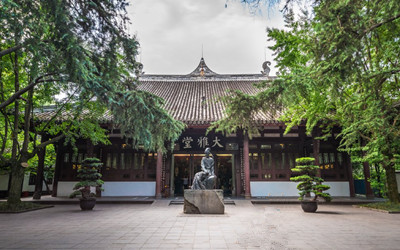Skype: neodalle-travel
Tel: +86 135 7447 2266
E-mail: sales@visitaroundchina.com

The Thatched Cottage of Du Fu covers a total area of 24 hectares (about 59 acres), and is the co mbination of both Fan'an Temple in the east and the Plum Garden in the west. As a popular attraction in Chengdu City, the Du Fu Thatched Cottage stretches out its arms to welcome visitors from all over the world.
 Construction inside belongs to the Qing Dynasty (1644-1911) style, with gardens in the unique compound style of traditional Chinese gardening. Inside the thatched cottage: gardens are quiet; streams are winding; bridges and pavilions are interwoven; trees reach for the sky; plum trees and bamboos stand side by side; and classical architectural styles bring you a strong cultural atmosphere. Besides, whenever you walk here, you will feel uplifted, because the plum blossoms in spring, the lotus flowers in summer, the chrysanthemums in autumn and the orchids in winter will bring you the enjoyment of both man-made beauty and nature's romance.
Construction inside belongs to the Qing Dynasty (1644-1911) style, with gardens in the unique compound style of traditional Chinese gardening. Inside the thatched cottage: gardens are quiet; streams are winding; bridges and pavilions are interwoven; trees reach for the sky; plum trees and bamboos stand side by side; and classical architectural styles bring you a strong cultural atmosphere. Besides, whenever you walk here, you will feel uplifted, because the plum blossoms in spring, the lotus flowers in summer, the chrysanthemums in autumn and the orchids in winter will bring you the enjoyment of both man-made beauty and nature's romance. and the Gong Bu Temple. On each side there are cloisters and other attached buildings echoing each other. This layout gives the place solemnity, simplicity, elegance, and grace.
and the Gong Bu Temple. On each side there are cloisters and other attached buildings echoing each other. This layout gives the place solemnity, simplicity, elegance, and grace.History of thatched Cottage of Du Fu
Du Fu, a very famous poet, lived in the Tang Dynasty(618-907). Just as its name implies, the Thatched Cottage of Du Fu was his home more than a thousand years ago.
 Du Fu was born in Gongyi City, Henan Province in 712. In 746, he took the official examination in Chang'an (now known as Xian) and continued to live there for more than teyears after the failure. But, in order to get away from the An-Shi Rebellion breaking out in 758, he fled to Chengdu in 759. With the help of friends, the thatched cottage was built in 760 beside the Flower Bathing Brook on the western outskirts of Chengdu. During the four years stay there, he composed more than 240 poems that are considered to be precious national treasures.
Du Fu was born in Gongyi City, Henan Province in 712. In 746, he took the official examination in Chang'an (now known as Xian) and continued to live there for more than teyears after the failure. But, in order to get away from the An-Shi Rebellion breaking out in 758, he fled to Chengdu in 759. With the help of friends, the thatched cottage was built in 760 beside the Flower Bathing Brook on the western outskirts of Chengdu. During the four years stay there, he composed more than 240 poems that are considered to be precious national treasures.
After Du Fu's departure from Chengdu, the cottage was abandoned for a long time and became dilapidated. Hundreds of years later in the Northern Song Dynasty (960-1127) a new temple was built on the original site to commemorate this outstanding person in Chinese literature. From then on, it was renovated and enlarged repeatedly. There were two very important reconstructions in 1500 and 1811 respectively, both of which set the scale and structure of the present thatched cottage. Today, it is a shrine to Chinese literature and a commemorative museum in the form of a traditional garden.
Travel Tips
Add: Chengdu City, China
Entrance Fee: CNY 60
Opening hours: 08:00-18:30
 Ask Questions ?
Ask Questions ?